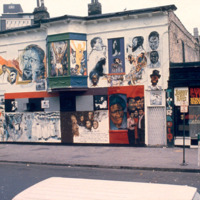![Mary Patten, Douglass Street Mural, 389 Douglass St, Brooklyn, NY, 1976 [destroyed 1989].jpg Mary Patten, Douglass Street Mural, 389 Douglass St, Brooklyn, NY, 1976 [destroyed 1989].jpg](https://486312.frmmmguz.asia/files/square_thumbnails/95232a9ffb9e9bde28fc73b69fc9109a.jpg)
Douglass Street Mural
Mary Patten painted Douglass Street Mural – Cityarts Workshop’s first Brooklyn-based project – in 1976. Over a five-month period, Patten led a group of 20 teens and adults to develop various themes for the mural that would be located on Douglass Street in the Park Slope area of Brooklyn - an area more commercial than residential at the time. Community meetings and bilingual flyers filled the neighbourhood in the hope of garnering community input and consensus over the choice of imagery. The three-storey mural takes advantage of the building's structure by presenting the image as book pages waiting to be read. The dystopian nightmare to the right-hand side of the mural attempts to encroach on the multicultural utopian melting pot to the left, only to be fended off by workers and important figures from U.S. history. Folded into the Puerto Rican flag and the red, white and green banner of the African National Congress, are the images of Harriet Tubman, pointing towards the nightmare-scape, alongside Frederick Douglass, Lolita Lebrón, Malcolm X and H. Rap Brown. Under the imperialist eagle and puppet-like figure in its talons, Patten depicts a recent firebombing that had destroyed the homes of several Black families a few blocks away. Speaking of the large rainbow in the image, the muralist incorporated it to show "what is possible when people work and fight together to create what we need: a community school that provides quality education; people sharing skills and tools; dancing together; making music and painting a mural."The mural sought to convey hope and determination in the face of oppression. But by the 1980s, the mural had become obscured by new housing developments.
![John Weber, All Power to the People, Cabrini-Green Public Housing Development, 357 W. Locust St, Chicago, 1969 [destroyed].jpg John Weber, All Power to the People, Cabrini-Green Public Housing Development, 357 W. Locust St, Chicago, 1969 [destroyed].jpg](https://486312.frmmmguz.asia/files/square_thumbnails/5bee9c55de2e128c0239ac4a0793b9c0.jpg)
All Power to the People
In 1969, in the courtyard of Saint Dominic’s Church in Cabrini-Green, John Pitman Weber painted All Power to the People with a team of black teenagers. The 37-foot-long mural put the antislavery leader Frederick Douglass alongside Malcolm X, Huey P. Newton and Erika Huggins on the right-hand-side. On the left are skeletons of police officers and a statement by the leader of the Chicago Black Panther Party, Fred Hampton: "Dare to Struggle, Dare to Win." A raised Black Power fist, enveloped by flames, holds broken chains in a symbol of self-emancipation. A few months after the creation of this mural, Fred Hampton was shot and killed by the FBI under J. Edgar Hoover’s COINTELPRO. Weber was a white Harvard graduate and Fulbright scholar. The mural was one of the first collaborations between untrained community residents and a trained artist, a method that became common practise for American community murals.

Wall of Respect
The Wall of Respect was the first exterior African American mural in the United States. Painted by OBAC (Organisation of Black American Culture), it underwent three main phases, as shown throughout the photographs here. Its creation was an inclusive process, asking local residents to decide which black heroes should be included in the mural. This was an integral step in the mural-making process because “any muralist who’s doing anything of a thoughtful nature should always have an input from the community,” artist Bill Walker observed. “You can’t do things that make people think they’re not a part of things.” Compiling a newsletter and consulting local militant street gangs, OBAC wrote a list of historic and contemporaneous figures to be memorialised on the wall, before waiting for their approval. “The militant [members of the community] were the ones that defined who would go on the wall and who would not,” artist Eugene Eda Wade remembers in a 2017 oral history interview. The choices were figures from the past and present who “charted their own course” through life and “did not compromise their humanity,” including the antislavery leader Nathaniel Turner, as well as James Brown, James Baldwin, Thelonious Monk, Malcolm X, Nina Simone, Claudia McNeil, Stokely Carmichael, H. Rap Brown, Elijah Muhammad, Gwendolyn Brooks and Muhammad Ali. By celebrating radical black heroes of the past and present, the mural became a site of black cultural heritage and an unofficial landmark on Chicago’s southside. It also catalysed a national mural movement, with more than 300 murals painted in Chicago alone over the next few decades. In 1971, the mural was destroyed in a fire.